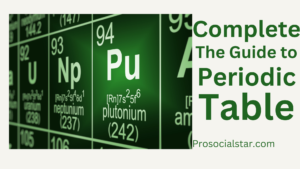Introduction
The Periodic Table is a fundamental tool in chemistry that organizes all known chemical elements into a structured format. It’s utilized to anticipate the properties and ways of behaving of components, making it fundamental for understudies, teachers, and experts the same.

This article will investigate different parts of the Intermittent Table, from its set of experiences and design to current patterns and devices that make finding out about it more intelligent and locking in.
Complete Guide to the Periodic Table: History, Trends, and Tools
What is the Periodic Table?
Definition and Importance
The Periodic Table is a chart that displays chemical elements organized by their nuclear number, electron setup, and repeating synthetic properties. It’s an important device for scientists and understudies, giving an extensive outline of the components and their connections.
Brief History of the Periodic Table
The concept of organizing elements dates back to the early 19th century. Dmitri Mendeleev made the first generally perceived Occasional Table in 1869. His course of action depended on the nuclear masses of components and anticipated the properties of components that presently couldn’t seem to be found.
Periodic Table for Kids
Simplified Explanation for Young Learners
For children, the Periodic Table can be an overwhelming point. Improving on the idea assists youthful students with understanding it better. Consider the Intermittent Table a goliath puzzle where each piece (component) has its novel properties and spots.
Fun Facts and Activities
Make learning fun with interactive activities and games. For instance, you can make an Intermittent Table scrounger chase where children find things that relate to various components. Numerous instructive applications offer youngsters well-disposed clarifications and games.
The Structure of the Periodic Table

Layout and Organization
The Periodic Table is organized into rows called periods and columns called groups. Components are put into these classifications in light of their nuclear design. Metals, nonmetals, and metalloids are dispersed across the table in a manner that mirrors their properties.
Elements and Their Placement
Each element is represented by a box that includes its atomic number, symbol, and atomic weight. Components are organized and arranged by expanding nuclear numbers, with comparative properties tracked down in segments.
Periodic Table Trends 2024
Recent Updates and Changes
In 2024, there have been a few updates to the Intermittent Table, including the expansion of new components and the refinement of component classifications. These progressions reflect continuous exploration and disclosures in the field of science.
Emerging Trends in Chemistry
Recent fads in science remember progressions for manufactured components and materials, as well as expanded centers around supportable and green science. These patterns are impacting the way that the Occasional Table is utilized in present-day examination and industry.
Interactive Periodic Table Apps
Popular Apps and Their Features
Interactive Periodic Table apps have revolutionized how students and professionals interact with this essential tool. Apps like “Periodic Table 2024” and “Chemistry Quiz” offer features such as detailed element information, quizzes, and interactive diagrams.
Benefits of Using Interactive Apps
Interactive apps make learning about the Periodic Table more engaging and accessible. They offer dynamic visuals, easy access to up-to-date information, and the ability to test your knowledge with built-in quizzes.
Printable Periodic Tables
Where to Find and How to Use Them
Printable Periodic Tables are widely available online and can be a useful resource for study and reference. Websites like Education.com offer free, downloadable versions.
Customizing Printable Tables
You can also customize your Periodic Table printouts with various designs and formats. Adding color-coded groups or personal notes can make the table more useful for specific learning needs.
Periodic Table for Chemists
Advanced Usage in Professional Chemistry
Chemists use the Periodic Table to predict element behaviors, identify chemical reactions, and understand complex chemical systems. Advanced features of the table include the use of electron configurations and periodic trends to guide research and experimentation.
Important Element Groups and Their Uses
Different groups of elements have specific applications. For instance, transition metals are crucial in industrial catalysts, while noble gases are used in lighting and refrigeration. Understanding these groups helps chemists apply their knowledge effectively.
Periodic Table Quiz for Students

Educational Quizzes and Games
Quizzes and educational games are excellent tools for reinforcing knowledge about the Periodic Table. Platforms like Quizlet offer a range of interactive quizzes that can help students memorize element names, symbols, and properties.
How Quizzes Help Learning
Intermittent Table tests are advantageous for dynamic learning and maintenance. They urge understudies to apply their insight in tomfoolery and connecting ways, making the growing experience more compelling.
History of the Periodic Table
Key Figures and Milestones
Key figures in the development of the Periodic Table incorporate Dmitri Mendeleev, who initially coordinated the components, and Glenn T. Seaborg, who refreshed the table with the disclosure of the actinide series. These achievements address critical headways in how we might interpret science.
Development of the Periodic Law
The Periodic Law, which states that elements’ properties recur periodically when arranged by atomic number, has evolved. The underlying idea spread out by Mendeleev has been extended and refined with current revelations.
Periodic Table Explained Simply
Simplified Explanations for Beginners
For beginners, the Intermittent Table can be made sense of as a method for putting together components so those with comparative properties are gathered. Visual guides, for example, variety-coded tables and graphs, can help in figuring out these ideas.
Visual Aids and Diagrams
Diagrams that illustrate element groups, periods, and trends can be very helpful. These visual tools make abstract concepts more concrete and easier to grasp.
Expert Insights
Interviews with Chemists
Insights from experts in the field can provide a deeper understanding of the Periodic Table’s significance. Chemists often share their experiences and explain how they use the table in their research and teaching.
Insights on Teaching the Periodic Table
Educators also offer valuable perspectives on effective teaching methods for the Periodic Table. Techniques such as interactive demonstrations and hands-on experiments can enhance students’ understanding and retention.
Future Outlook or Practical Applications
Future Developments in the Field
Future developments in chemistry may include the discovery of new elements and advancements in theoretical models. These changes will continue to influence the Periodic Table and its applications.
Practical Uses in Education and Industry
The Periodic Table remains a vital tool in both educational settings and industrial applications. It helps students learn fundamental concepts and assists professionals in various fields, from materials science to pharmaceuticals.
Conclusion
In summary, the Periodic Table is more than just a chart; it’s a dynamic tool that provides essential insights into the elements and their interactions. By grasping its design, history, and present-day applications, students and experts the same can see the value of its importance in the realm of science.

I would just say amazing, extraordinary work, keep it up it helped me a lot with my history. I was searching for periodic table history, you want believe me that this website poped up on the top.
Thanks for your kind words. Keep visit this website for more study tips and other type of content.
I read this article carefully, this is really help full. Thanks
I read this article carefully, this is really help full. Thanks